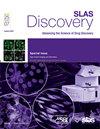Genetically encoded fluorogenic RNA-based bioluminescence resonance energy transfer (BRET) sensors for cellular imaging and target detection
IF 2.7
4区 生物学
Q2 BIOCHEMICAL RESEARCH METHODS
引用次数: 0
Abstract
Fluorescence- and bioluminescence-based probes are valuable tools for understanding cell functions in health and disease. Bioluminescence offers an ideal complementary readout to fluorescence due to its minimal background interference and self-illuminating nature. We previously introduced the first type of genetically encodable RNA-based bioluminescence resonance energy transfer (BRET) sensors. These RNA-based probes are highly programmable and can be modularly engineered to detect various cellular targets. While this system was successfully validated in vitro and from the entire cell population within a microplate, the BRET signals were quite dim and difficult to visualize at the single-cell level under a microscope. The ability of single-cell bioluminescence imaging is critical for studying cell-to-cell variations and spatiotemporal changes of cellular targets in different signaling pathways or upon drug treatment. In this study, we will introduce strategies that can enhance the functionality and capability of RNA-based BRET sensors for real-time cellular imaging and sensing. Using commonly used widefield microscopes, single-cell bioluminescent detection of various metabolites and other small molecules can be achieved in both bacterial and mammalian cells. This advancement represents a significant step toward the future development of genetically encoded RNA-based bioluminescent tools for studying disease mechanisms, high-throughput drug screening, and in vivo imaging.

基于基因编码荧光rna的生物发光共振能量转移(BRET)传感器,用于细胞成像和目标检测。
基于荧光和生物发光的探针是了解健康和疾病中细胞功能的宝贵工具。生物发光提供了一个理想的互补读出荧光由于其最小的背景干扰和自发光的性质。我们之前介绍了第一种基于遗传可编码rna的生物发光共振能量转移(BRET)传感器。这些基于rna的探针是高度可编程的,可以模块化地设计来检测各种细胞目标。虽然该系统在体外和微孔板内的整个细胞群中成功验证,但在显微镜下,BRET信号相当模糊,难以在单细胞水平上可视化。单细胞生物发光成像的能力对于研究不同信号通路或药物治疗下细胞靶点的细胞间变异和时空变化至关重要。在本研究中,我们将介绍可以增强基于rna的BRET传感器用于实时细胞成像和传感的功能和能力的策略。使用常用的宽视场显微镜,可以在细菌和哺乳动物细胞中实现各种代谢物和其他小分子的单细胞生物发光检测。这一进展代表了未来基于遗传编码rna的生物发光工具在研究疾病机制、高通量药物筛选和体内成像方面的重要一步。
本文章由计算机程序翻译,如有差异,请以英文原文为准。
求助全文
约1分钟内获得全文
求助全文
来源期刊

SLAS Discovery
Chemistry-Analytical Chemistry
CiteScore
7.00
自引率
3.20%
发文量
58
审稿时长
39 days
期刊介绍:
Advancing Life Sciences R&D: SLAS Discovery reports how scientists develop and utilize novel technologies and/or approaches to provide and characterize chemical and biological tools to understand and treat human disease.
SLAS Discovery is a peer-reviewed journal that publishes scientific reports that enable and improve target validation, evaluate current drug discovery technologies, provide novel research tools, and incorporate research approaches that enhance depth of knowledge and drug discovery success.
SLAS Discovery emphasizes scientific and technical advances in target identification/validation (including chemical probes, RNA silencing, gene editing technologies); biomarker discovery; assay development; virtual, medium- or high-throughput screening (biochemical and biological, biophysical, phenotypic, toxicological, ADME); lead generation/optimization; chemical biology; and informatics (data analysis, image analysis, statistics, bio- and chemo-informatics). Review articles on target biology, new paradigms in drug discovery and advances in drug discovery technologies.
SLAS Discovery is of particular interest to those involved in analytical chemistry, applied microbiology, automation, biochemistry, bioengineering, biomedical optics, biotechnology, bioinformatics, cell biology, DNA science and technology, genetics, information technology, medicinal chemistry, molecular biology, natural products chemistry, organic chemistry, pharmacology, spectroscopy, and toxicology.
SLAS Discovery is a member of the Committee on Publication Ethics (COPE) and was published previously (1996-2016) as the Journal of Biomolecular Screening (JBS).
 求助内容:
求助内容: 应助结果提醒方式:
应助结果提醒方式:


